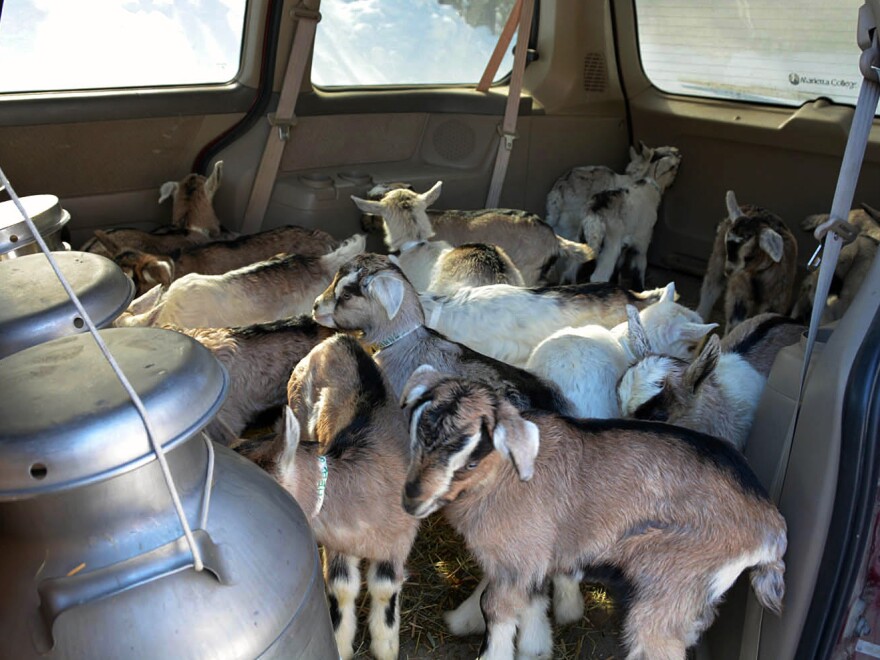It's easy to find goat milk and goat cheese in Vermont. Goat meat, not so much.
That's frustrating for the refugees, immigrants and others who've settled in the state who are accustomed to eating fresh goat meat. Though it's not so common in the U.S., it's a mainstay in many African, Asian and Caribbean diets.
But there's a movement afoot to meet the demand for goat meat throughout New England.
A project called the Vermont Goat Collaborative is providing new Americans with the opportunity to raise and sell goats to members of their community. Now in its second year, the collaborative makes use of an abundant — and often unwanted — class of animal: male baby goats from goat dairy farms.
But first, a bit of terminology: Baby goats are called kids. Male baby goats are called bucklings.
On a recent clear, frigid afternoon, Theoneste Rwayitare helped shuttle 57 bucklings in and out of a pen with a small milking station. The kids, some as young as a week old, only stopped bleating when they found the plastic nipples that yielded warm powdered milk.
Rwayitare is a Rwandan refugee. He arrived in Vermont just a year ago, joining his brother Theogene Mataro, who had resettled there several years prior.
In February, the brothers joined Chuda Dhaurali, a Bhutanese refugee, at the 's Pine Island Farm in Colchester.

All three have experience in the goat market. Dhaurali spent nearly 20 years working more or less as a goat trader in a refugee camp in Nepal. And Rwayitare says goats were one of many animals that his family raised in Rwanda.
"The goat are not complicated to farm [in Kenya]," he says. "[It's not] hard work."
Before Dhaurali became the first farmer at the Vermont Goat Collaborative, he would drive all the way to Boston to find goat meat.
Now it's just a matter of traveling a few miles outside of town, says Karen Freudenberger, the brains behind the operation.
Before Freudenberger got this project off the ground, most goat consumed in Vermont was coming from much farther away than Boston. She says that every year, Vermont businesses import 3,000 goats from Australia and New Zealand.
"That seemed, on the one hand, a travesty in a state that's trying to maintain its working landscape, but on the other hand a huge opportunity," she says.
There's already a good supply of bucklings in Vermont. They're born on the dairies that produce cheese and yogurt. Those farms only raise up females — male goats are essentially useless on these operations, since they can't be milked.
That means that bucklings born on dairy farms often meet an unfortunate end.
"Especially on the very large farms, they would just tend to compost the babies at birth," Freudenberger says. "And many other farms just felt so uncomfortable doing that that they took huge amounts of time to go around and find people who wanted a pet goat."
The collaborative is still a tiny operation, catering to a small market of immigrants and refugees. But Shirley Richardson has much grander designs for the goat meat industry.
In 2011, Richardson started . Chevon is another word for goat meat. And the organization is devoted to scaling up the dairy goat meat model until Vermont is a major regional exporter.
"We used to be a main exporter of goat meat, but right now we're a main importer. It's a significant economic opportunity for the state of Vermont to become a center where the animals are raised," she says.
At least part of Richardson's plan for a Vermont goat boom is contingent upon a broader market for the meat.
For the uninitiated, Theoneste Rwayitare recommends a delicacy called brochette.
"You put [the meat] on a stick," he says, "and you prepare with barbecue. When you eat brochette with barbecue, it really, really tastes good."
Good, and good for you, with as much protein as beef.
Copyright 2020 NPR. To see more, visit https://www.npr.org. 9(MDAxNDQ2NDAxMDEyNzU2NzM2ODA3ZGI1ZA001))



